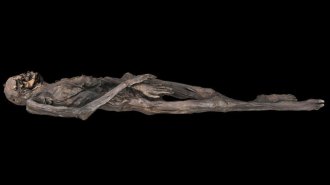Ancient Andean Maize Makers: Finds push back farming, trade in highland Peru
Nearly 4,000 years ago, large societies emerged in the Andes Mountains of southern Peru that would culminate approximately 3,000 years later in the rise of the Inca civilization. Now, scientists have the first evidence that these Inca predecessors cultivated maize and imported plant foods from lowland tropical forests located 180 miles to the east.

Researchers have long theorized that ancient Andean civilizations exchanged goods with lowland sites. “Our results provide the earliest direct evidence of an important trade connection between highland and lowland sites in southern Peru,” says archaeologist Linda Perry of the Smithsonian Institution’s Archaeobiology Laboratory in Suitland, Md.
In the Andean highlands, maize previously had been dated only to 2,500 years ago.
Perry and her coworkers recovered fossilized, microscopic plant remains from soil samples and stone-tool surfaces at a highland site called Waynuna. Much of Waynuna consists of raised farm fields built around 1,200 years ago. However, the researchers focused their search on a house that they have partially excavated. Radiocarbon measurements placed the structure’s age at between 3,600 and 4,000 years.
Perry’s team identified 1,077 samples of either starch granules or silica-containing plant cells called phytoliths. Both granules and phytoliths come in distinctive forms that enable scientists to discern one plant species from another and to distinguish wild from cultivated plants.
Most of the plant remains examined came from maize, the researchers report in the March 2 Nature. Analyses revealed maize phytoliths from both leaf and cob. The leaf phytoliths provide a strong clue that Waynuna residents cultivated maize, Perry notes.
Many maize-starch granules displayed surface damage consistent with that produced by grinding with stone implements, such as those found at the site.
On one tool, the scientists recovered starch granules of arrowroot. This edible plant grows in lowland forests but not in mountainous regions.
Another stone fragment yielded the starchy remains of a potato. Potatoes can be grown at Waynuna’s altitude—about 2 miles above sea level—but Perry’s group hasn’t determined whether the fossilized residues belong to a wild or a domesticated species. Given the site’s location near modern potato and maize farms, “it wouldn’t be surprising if [prehistoric] people were growing potatoes at Waynuna,” Perry says.
Other investigators previously estimated that potato-starch granules found at Peruvian coastal sites date to between 4,000 and 3,000 years ago.
Waynuna lies near a major source of raw obsidian, a rock that held great symbolic meaning for ancient inhabitants of this region. Obsidian may have been traded for arrowroot and other lowland crops, such as peanuts and manioc, the researchers suggest. They plan to look for additional remains of lowland plants at Waynuna.
The discovery of imported arrowroot at Waynuna fits the theory that interactions among Peruvian coastal, highlands, and eastern-lowlands sites fostered the growth of early Andean societies, comments Yale University archaeologist Richard Burger.
“It’s reasonable to suspect that a gradual uphill movement of maize, potatoes, and arrowroot into ever-starker environments transpired long before [their documented use at Waynuna,” remarks archaeologist Michael E. Moseley of the University of Florida in Gainesville.







